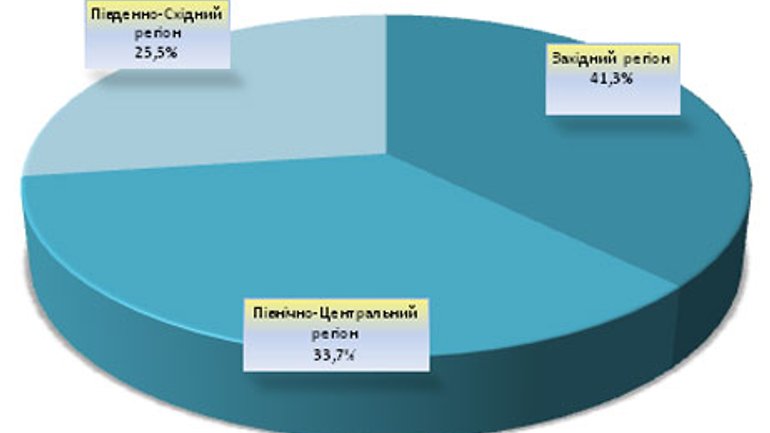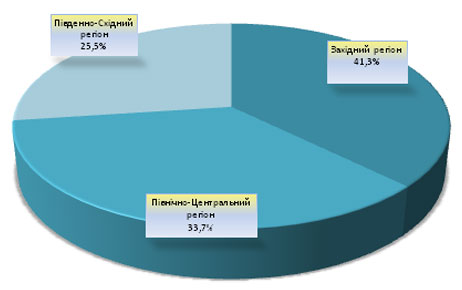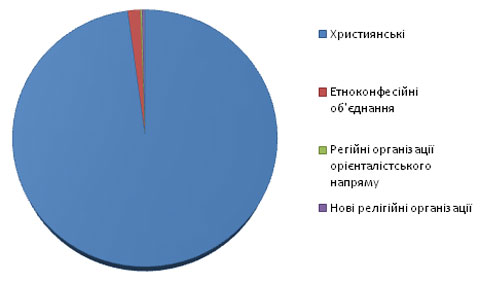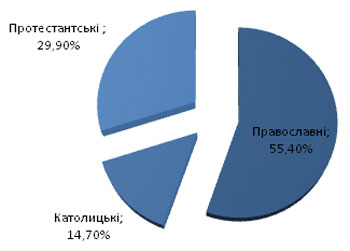Religious network of Ukraine: analysis of dynamics at the beginning of 2016

Analysis of expansion of religious institutions gives reason to conclude that the religious network has become sustainable in its quantitative indicators. It should be noted that the rapid development of the religious environment immediately occurred in the first years of Ukrainian independence certifying the intensive growth of the institutional network of religious organizations in the country. One can make certain correlation between quantitative composition of religious organizations and the processes in the religious environment of the country and vice versa, the processes occurring in the religious environment in a certain way affect the number of members of religious organizations. In that context, to analyze current issues in relations between the state and religious organizations and interfaith issues, one should have a command of empirical material in relation to quantitative indicators of the situation of religious organizations, which in turn will help in the practical field of research.
In Ukraine, as of January 1, 2016, the religious network is represented by 35,709 [i] institutions of religious organizations. Compared with the last year there is a slight increase of the network - to 392 units, which is 1.0%. For example, the growth in the past five years was: in 2014 - 0.9%, in 2013 - 0.6%, in 2012 - 1.4%, in 2011 - 1.8 % in 2010 -1.9%; and Ukraine for the period of independence (25 years) the overall increase was 2.9 times.
Analyzing the percentage of growth in the religious network over the past five years, one can see a tendency for its reduction. One should also take into account the facts that the state statistics of the last two years (2014 and for 2015) is given without performance network of religious organizations of Crimea (note that as of January 1, 2011 in Crimea there were 2,083 religious organizations ), since the latter has been annexed by the Russian Federation, and in a part of Donetsk and Luhansk regions (the so-called “Donetsk People's Republic” and “Luhansk People's Republic”), the religious organizations are denied the opportunity to act in accordance with Ukrainian legislation. Currently, neither local nor central executive authorities have official, full and objective statistical information about the actual termination or continuation of the activity of religious organizations in these areas. [Ii]
It should be noted that over 2015 specialists of the State Department for Religions and Nationalities to the Ministry of Culture in cooperation with representatives of the Expert Committee on Freedom of Conscience and Religious Organizations to the Ministry of Culture have developed and introduced innovations pertaining to statistical reporting of the religious network.
The attention should be paid to the fact that during the period of Ukraine's independence the structure of statistical forms were regularly amended and these amendments were prepared by a central executive body, whose jurisdiction encompassed the implementation of state policy in the religious sector. It should be also noted that these changes do not always lead to positive effects (see more details on the above in other publications of the author).
Analyzing the structure of statistical reports of the state authorities of Ukraine on religions, one can distinguish four standards of presenting information as defined in the following time frame: from 1991 to 1994, from 1995 to 2003, from 2004 to 2015 and from 2016 (current standard).
Describing the current standard of statistical reporting on the network of religious organizations in Ukraine as of January 1, 2016, the direct innovations we would like to note are as follows:
The statistical reporting structure was supplemented (form 1). In particular, the clauses on presenting the information on the following issues were specified: religious communities (the points “active”, “inactive” were included); religious educational institutions (the points “higher theological institutions”, “secondary theological institutions”), schools (the point "general" was added) and periodicals (“print”, “audio-visual”, “online” menu items were added); the presentation of information on the network of religious organizations on blocks that define religious was arranged; the list of religious organizations was expanded, i.e. the point "other" was further detailed.
It should be noted that these changes in the statistical reporting of the network of religious organizations are detailing quantitative indicators of the religious network in the country and in turn, enable to get more information about the religious majority and minority of the country.
Let us further analyze the current statistical data on institutional network of religious organizations in Ukraine.
In the regional section, 2016 marked the growth dynamics in all regions of Ukraine, except Donetsk and Transcarpathian region, as well as in the city of Kyiv. Lviv region is the leader in the number of religious organizations - 3107 units, and the last in the list is Kirovohrad region – 766 units. The largest increase in religious communities in 2016 registered in the Vinnytsia region - 55 units, the smallest in Luhansk region (-1), Chernihiv region (+ 2) and Kirovograd region (+5).
Among the 35,709 registered bodies of the religious organizations in Ukraine, 33,085 have the legal status of religious communities, of which 32,497 are active and 588 are inactive.
The distribution of religious organizations by regions [iii] of Ukraine is as follows. As of January 01, 2016, the west region ranked first in the number of religious organizations, where 42.3% organizations of the country’s religious network are operating. In the second place is the North Central region - 33.7%; respectivelyб the Southeast region ranks third - 25.5%. Note that already in January 2000, based on the regional distribution, among the 23,543 religious organizations the West region ranked first- 42.8%, the second was the North Central region - 33.7%, and the third was Southeast region - 23 5%.
The percentage ratio of the number of religious organizations in the regions of Ukraine as of January 1, 2016

Having lost throughout 2005-2015 the leading position by the number of components of the church infrastructure and the church communities (from 12801 to 14336 in the central regions), in the population aspect the region remains the highest by saturation of active religious organizations and active church life.
One can state that there has been a slowdown of increase in religious organizations over the last fifteen years in the Western region, and in North-Central region, on the contrary, this number has grown more rapidly. Speaking of the richness of the religious network in the Western region, the regional institutional network of confessional church organizations sufficient to meet the religious needs of the faithful has been established, which in fact has been mentioned in the information report of the Ministry of Culture of Ukraine “On the status and trends of the religious situation and state-confessional relations in Ukraine.”
Compared to last year, the total number of religious centers has decreased by one unit. With respect to the dynamics of change, throughout 2016 the centers of religious organizations in Vinnytsia, Donetsk, Zaporizhia and Chernihiv regions were deregistred, one unit per region and two units in Kyiv. And one center was registered in Kirovohrad region. As of January 1, 2016, they were 86 in the territory of Ukraine. It should be noted that, according to regional distribution of the reorganization centers, at the beginning of 2016 they were absent in Luhansk, Mykolaiv, Poltava, Rivne, Sumy, Ternopil, Kharkiv, Kherson, Cherkasy and Chernihiv regions.
The existing 86 centers have the respective geographic locations: 53 centers of religious organizations operate in Kyiv, 6 in Donetsk region, 5 in Lviv, 3 in Volyn, Transcarpathian and Odessa regions respectively, 2 in Kyiv region, and one center of religious organizations in Zhytomyr, Zaporizhzhia, Ivano-Frankivsk, Kirovohrad, Khmelnytsky and Chernihiv regions respectively. According to these statistics, one can see that the leader by the specified indicator is Kyiv as the capital of Ukraine and it hosts all central administrative authorities of the state.
Certain modifications of religious offices have taken place. In particular, one unit has been registered in Vinnytsia, Donetsk, Zaporizhia, Ternopil, Kherson and Chernivtsi regions and in Kyiv; and 5 units have withdrawn their registration in Zhytomyr region. However, their total number remains similar to the last year - 292 units. The religious directorates operate in all administrative areas of Ukraine.
Compared to last year, the number of priests has grown by 74 people, which is 31,855 people, including 764 foreigners. It should be noted that the foreign clergymen arrived for the most part from the USA, Germany, Canada, Turkey, Asia, Africa, Latin America and Russia. Over 2015, the largest quantities of foreign priests invited by religious organizations were in the Roman Catholic Church in Ukraine (RCC), the Church of Jesus Christ of Latter-day Saints and religious organizations of the Evangelical Christians-Baptists etc.
Thus, the total availability of clergy personnel in religious organizations as of January 1, 2016 was 94.8% (the last year the figure was 94%). The proportion of foreigners among the clergy shows a tendency to decrease, in 2015, it was 2.3%. For example, while fifteen years ago, in 2000, it was 3.5%, five years ago, in 2011 is became 2.5%. These figures witness the trend to reduction of invited foreign clergymen in Ukraine and in particular, the effectiveness of the training for religious organizations, which began to develop rapidly in Ukraine since the mid-1990s [iv]. However, the preparation of the own clergy staff remains in part relevant for Ukrainian religious environment.
The number of monasteries remains unchanged. The largest number of monasteries among the administrative units of the country in 2016 has been located in Lviv (67), Ternopil (42) and Ivano-Frankivsk (35) regions. Therefore, at the beginning of 2016 there were 526 monasteries. As compared to previous year, the number of monks and nuns in monasteries has decreased by 38 people. It should be noted that over the past ten years, the total number of monasteries has grown to 73.4%. However, the number of monks and nuns is only 36.5 %. Such divergences in growth rate of the number of monasteries, on the one hand, and among the monks - on the other, were also characteristic of the previous period, which gives reason to believe that churches and monastic life are still in the making [v]. Note that among the religious organizations that operate in Ukraine, the institute of monasteries is present in such religious denominations and trends as Orthodoxy, Catholicism and Buddhism.
At the beginning of 2016, the number of missions decreased for the total number of six (according to the dynamics, changes occurred in Ivano-Frankivsk (-1), Sumy (-1), Kharkiv (-1) regions and in Kyiv (-8), Zaporizhia (+1), Lviv (1), Nicholas (1) Ternopil (1), Zhytomyr regions (4)) and by three brotherhoods (according to the dynamics, changes took place in Zhytomyr (-1), Transcarpathian (-1), Ternopil (-1), Ivano-Frankivsk (3) regions and Kyiv region (-3)). Note that the Mission religious organizations covering all regions of Ukraine, but the Brotherhood are at the beginning of 2016 are in nineteen administrative units of Ukraine (most of them 21 in Kyiv, 10 in Ivano-Frankivsk, 8 Transcarpathian Region, 6 in Khmelnytskyy region, 5 in Vinnytsia region, etc.). In fact, at the beginning of 2016, 359 missions and 75 fraternities operated.
In 2016, there were 198 religious schools in Ukraine, including 129 senior theological schools and 69 secondary theological schools. As for the territorial-administrative organization, it should be noted that religious schools are present in most regions of Ukraine, except Kirovohrad and Mykolayiv regions. For example, from 2000 to 2005 they increased by 38.9%, from 2005 to 2010 – by 14.3%, and from 2010 to 2015 – by 11.6%. One can see a slowdown in growth in the last ten years, but the quantitative values are increasing.
It should be noted that in 2016 there has been a sharp decrease in the number of students (by 8038 people) in theological educational establishments. The decrease in the number of students in religious schools has been observed since 2005 in almost all religious organizations that run them, in addition to Islamic and Jewish schools. Reduction in the number of students forced to move some religious schools solely on distance learning. For example, it can be observed in Cherkasy and Chernivtsi regions. One can also claim that compared to 2000 the share of extramural students of religious educational institutions has increased.
As of January 1, 2016, Ukraine have had 12,183 schools founded by religious organizations, of which 12 175 have been Sunday schools, and 6 secondary schools. In turn, Sunday schools are represented in all the administrative centers of Ukraine, except for Dnipropetrovsk and Sumy region. Their total number, though, has decreased by 231 units compared to the previous year. The number of Sunday schools and dynamics of their network growth shows, in particular, the level of activity of religious organizations in ensuring their succession [vi]. The remaining 8 (general education) operate in Vinnytsia (3), Lviv (3), Ivano-Frankivsk (1), Kirovohrad (1) regions.
Now let us turn to peculiarities of the denominational section of the religious network in the country. In 2004, while preparing statistical reports the National Committee unified the confessional network of the country.
The unification encompassed the trends that have Orthodox roots, some Protestant (Baptists, evangelicals, Presbyterians, Lutherans and others), charismatic, Muslim, Orientalist, pagan, independent, interdenominational and foreign religious organizations that were merged in the paragraphs entitled “Other”, for example “Other Orthodox religious organizations”, “Other religious organizations of Evangelical Christians-Baptists” [vii], etc. It can be noted that the data from the existing statistical report template allow tracking the quantitative changes both of the total number of religious organizations in the country and among the large religious organizations. But it should be noted that it is difficult to follow the dynamics of the religious minorities of the country using these data. [Viii]
As stated above, that statistical reporting, which has been published in the current year (2016), expanded the list of religious organizations, i.e. detailed its mostly unified units called “other.”
Therefore the list of religious organizations in the “Report on the network of religious organizations as of January 1, 2016 (Form 1)” includes ninety-eight positions (i.e. in the period from 2004 to 2015 the data cited related only to fifty two names of religious organizations).
It should be states that the current statistical report provides not only a list of names of religious organizations, the information is structured in blocks that define religious trends.
Thus, the present structure of information in the statistical report on religious trends and their quantitative and percentage indicators, without detailing the names of religious organizations (one can look up the names of religious organizations and their quantitative indicators directly referring to the “Report on the network of religious organizations as of January 1, 2016 (form 1)”).
Christianity - 34,664 units, representing 97% of the religious institutions. They include:
Orthodox religious organizations -19 210 units, representing 55.4% of Christian organizations;
Catholic religious organizations -5106 units, representing 14.7% of Christian organizations;
Protestant religious organizations -10,348 units, representing 29.9% of Christian organizations:
Religious Organizations Baptist - 3043 units, representing 29.4% of Protestant organizations;
Religious Organizations of Evangelical Christians – 387 units, representing 3.7% of Protestant organizations;
Religious Organizations Evangelical Christians – 2815 units, representing 27.2% of Protestant organizations;
Adventist religious organizations – 1102 units, representing 10.6% of Protestant organizations;
Lutheran Religious Organizations – 85 units, representing 0.9% of Protestant organizations;
Reformed religious organizations – 132 units, representing 1.3% of Protestant organizations;
Charismatic religious organizations – 1414 units, representing 13.6% of Protestant organizations;
Other Protestant religious organizations (of Protestant origin) – 1380 units, representing 13.3% of Protestant organizations.
Ethno-confessional religious organizations – 577 units, which is 1.6% of the total number of religious institutions. They include:
Islam - 238 units, representing 41.3% of the ethno-confessional religious organizations;
Judaism – 300 units, representing 52% of the ethno-confessional religious organizations;
Karaite religious organizations – 4 units, representing 0.7% of ethno-confessional religious organizations;
Armenian religious organizations - 26 units, representing 4.5% of ethno-confessional religious organizations;
Other ethno-confessional religious organizations - 9 units, representing 1.5% of ethno-confessional religious organizations.
Buddhism - 61, representing 0.2% of the total number of religious institutions.
New religious organizations – 407 units, which is 1.2% of the total number of religious institutions. They include:
New religious organizations of Orthodox origin - 6 units, representing 1.5% of new religious organizations;
New religious organizations of Jewish origin - 47 units, representing 11.6% of the new religious organizations;
New pagan religious organizations -150 units, representing 36.9% of the new religious organizations;
New religious organizations of Orientalist origin - 94 units, representing 23% of new religious organizations;
Other new religious organizations -110 units, representing 27% of new religious organizations.
It should be noted that at the beginning of 2016 there have been 35,709 institutions of religious organizations.
In view of the above we can state that among the religious trends presented in Ukraine the Christian trends dominate, their quantity is 34,664, or 97% of the religious network.
The largest denomination among the above is Orthodoxy, its religious association account for 55.4% of Christian organizations. Protestantism ranks second - 29.9%, Catholicism - 14.7%.
The ethno-confessional associations (1.6% of the religious network in the country), religious organizations Orientalist trend (0.2%), new religious organizations (1.2%) representing the religious minorities of the country operate in Ukraine.
The ratio of registered religious organizations in Ukraine as of January 1, 2016

The ratio of registered in Christian denominations of Ukraine as of January 1, 2016

[i] These statistical data in the text, as of January 1, 2016, were used in the statistical report of the Ministry of Culture of Ukraine, i.e.: “Report on the network of religious organizations in Ukraine as of January 1, 2016 (Form No.1)” / Approved by the Ministry of Culture of Ukraine of 31 March 2016 No. 184.
[ii] The religious network, its personnel and material support: major trends, dynamics change, development prospects // Materials to the round table “The situation of the freedom of conscience and church-state relations in Ukraine” as of 28 October 2-15 / The Verkhovna Rada of Ukraine Committee on culture and spirituality Subcommittee for state policy on freedom of conscience and religious organizations. - B. c., P. 2.
[iii] The distribution in the regions referred to in this article means western, north-central and south-eastern regions. The western region includes Volyn, Ivano-Frankivsk, Lviv, Rivne, Ternopil, Chernivtsi regions, the north-central includes Vinnytsia, Dnipropetrovsk, Zhytomyr, Kyiv region, the city of Kyiv, Kirovohrad, Poltava, Khmelnytskyy, Cherkasy, Chernihiv region) and the south-east includes Donetsk, Zaporizhia, Crimea, Luhansk, Mykolaiv, Odesa, Sumy, Kherson, the city of Sevastopol).
[iv] Religion and authority in Ukraine: Problems of relationship. Information-analytical materials for the round table on “Church-state relations in Ukraine, their features and trends,” February 8, 2011. - K., 2011, p. 6.
[v] ibid. 7.
[vi] ibid. 8.
[vii] For example, see: The network of religious organizations as of January 1, 2004 // Churches and religious organizations of Ukraine in 2003. Directory / [ed. board: V.D.Bondarenko et al.]. - K: VIP, 2004. - S. 10-55.
[viii] Vladychenko L. Analyzing the tables ... Accounting and dynamics of the religious network in Ukraine
Larisa Vladychenko, Ph.D.,
Deputy Director of the Department - head of the division for expert-analytical work and relations with religious organizations to the Ministry of Culture









